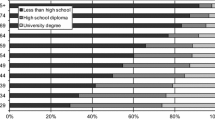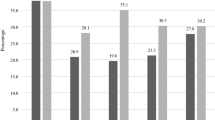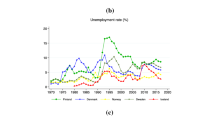Abstract
In this paper, we analyze the decline in the total fertility rate (TFR) in the Czech Republic during the economic transition. To identify transition-specific features of this decline, we estimate a Heckman–Walker multistate model of the birth process using data from the 1998 Family and Fertility Survey. We find that the negative effect of transition on TFR is mostly driven by a sharply increased influence of higher education, limited ability to combine employment with childbearing and lack of adequate childcare facilities. We also detect a significant role of the increased use of contraception, motivated by both economic and demographic reasons.







Similar content being viewed by others
Notes
To avoid measurement error bias in the first cohort, we consider only those females who have completed their education. This simultaneously reduces the efficiency loss due to censoring.
There are also some questions about the reasons for own fertility decisions, but very high nonresponse rates render these data useless.
This assumption is particularly appropriate in our case since we do not have income data, and individuals are surely heterogeneous with respect to income.
Identification of θ requires setting one of its elements to zero. Alternatively, one can suppress intercept term in x (see Heckman and Singer 1982, p.64).
Keep in mind, though, that the effect of employment intensity is still negative and significantly contributes to the delay of first birth as described by Happel et al. (1984).
This finding is more of a demographic nature and is quite similar to the results of Bonneuil (1997) on the dependence between fertility and urbanization. Analyzing cointegrating relationships between fertility and urbanization in France, Bonneuil (1997) demonstrates that with the fall of fertility rates, the positive effect of urbanization on birth postponement disappears.
We also ran the model for the youngest cohort without the belief variables to see whether this would change the other covariates (particularly the employment and education variables). It has very little impact on them, so that the results for these variables are robust to inclusion or exclusion of the belief variables.
Apart from purely economic reasons, the significant effect of the increased use of contraception may also have behavioral and demographic roots (see Bonneuil 1997).
References
Barmby T, Cigno A (1990) A sequential probability model of fertility patterns. J Popul Econ 3(1):31–51
Billari F, Kohler H-P (2002) Patterns of lowest-low fertility in Europe. Max Plank Institute for Demographic Research, Working Paper No. 2002-040, Koln
Burcin B, Kučera T (2000) Changes in fertility and mortality in the Czech Republic: an attempt of regional demographic analysis. In: Kuera T et al (eds) New demographic faces of Europe. Springer, Berlin Heidelberg New York, pp 371–417
Bonneuil N (1997) Transformation of the French demographic landscape 1806–1906. Clarendon, Oxford
Cigno A (1991) Economics of the family. Clarendon, Oxford
Covas F, Santos Silva J (2000) A modified hurdle model for completed fertility. J Popul Econ 13(2):173–188
del Boca D (2002) The effect of child care and part time opportunities on participation and fertility decisions in Italy. J Popul Econ 15(3):549–573
Dempster A, Laird N, Rubin D (1977) Maximum likelihood from incomplete data via EM algorithm. J R Stat Soc Ser B 39(1):1–38
Famoye F, Wang W (1997) Modeling household fertility decisions with generalized poisson regression. J Popul Econ 10(3):273–283
Gustafsson S (2001) Optimal age of motherhood. Theoretical and empirical considerations on postponement of maternity in Europe. J Popul Econ 14(1):225–247
Gustafsson S, Wetzels C (2000) Optimal age at first birth: Germany, Great Britain, The Netherlands and Sweden. In: Gustafsson S, Meulders D (eds) Gender and the labour market. Econometric evidence of obstacles to achieving gender inequality. MacMillan, London, pp 188–209
Gustafsson S, Kenjoh E, Wetzels C (2001) A new crisis in European populations. Do modern family policies help? In: Pieters D (ed) Confidence and changes: managing social protection in the new millennium. Kluwer, The Hague, pp 119–141
Happel S, Hill J, Low S (1984) An economic analysis of the timing of childbirth. Popul Stud 38(2):299–311
Heckman J, Singer B (1982) The identification problem in econometric models for longitudinal data. In: Hildenbrand W (ed) Advances in econometrics. Cambridge University Press, Cambridge, pp 39–77
Heckman J, Singer B (1984) A method of minimizing the impact of distributional assumptions in econometric models for duration data. Econometrica 52(2):271–320
Heckman J, Walker J (1987) Using goodness of fit and other criteria to choose among competing duration models: a case study of Hutterite data. Sociol Method 17:247–307
Heckman J, Walker J (1990a) The relationship between wages and income and the timing and spacing of births: evidence form Swedish longitudinal data. Econometrica 58(6):1411–1441
Heckman J, Walker J (1990b) The third birth in Sweden. J Popul Econ 3(4):235–275
Hotz V, Klerman J, Willis R (1997) The economics of fertility in developed countries. In: Rosenzweig A, Stark O (eds) Handbook of population and family economics, vol 1A. Elsevier, Amsterdam, pp 275–347
Kantorová V (2003) Education and entry into motherhood: the Czech Republic during state-socialism and the transition period. Max Plank Institute for Demographic Research, Working paper No. 2003–037, Köln
Klasen S (1993) Human development and women's lives in a restructured eastern block: lessons from the developing world. In: Schipke A, Taylor A (eds) The economics of transformation: theory and practise in the new market economies. Springer, Berlin Heidelberg New York, pp 253–294
Lancaster T (1990) The econometric analysis of transition data. Cambridge University Press, Cambridge
Mašková M, Stašová L (2000) Population development in the Czech Republic in the 1990s. In: Kuera T et al (eds) New demographic faces of Europe. Springer, Berlin Heidelberg New York, pp 88–102
Sobotka T (2001) Ten years of rapid fertility changes in European post-communist countries: evidence and interpretation. Working paper, University of Groningen, Groningen
Sobotka T (2004) Is lowest-low fertility in Europe explained by the postponement of childbearing. Popul Dev Rev 30(2):195–220
UNECE (2003) Family and fertility surveys. Population activities unit. URL: http://www.unece.org/ead/pau/ffs
White H (1982) Maximum likelihood estimation of misspecified modes. Econometrica 50(1):1–25
Acknowledgements
We would like to thank Michael Grimm, Siv Gustafsson, and the participants of ESPE 2004 and EEA 2005. Comments of an anonymous referee were especially useful. Funding from the German Science Foundation (DFG) within SFB 386: “Statistical Analysis of Discrete Structures” is greatly acknowledge.
Author information
Authors and Affiliations
Corresponding author
Additional information
Responsible editor: Allesandro Cigno
Appendix
Appendix
1.1 Direction of the effect and marginal effects
Waiting time
First, consider the effect of the covariates on Weibull hazard function
Since the first derivative with respect to x β is positive, the sign of the effect will always be equal to the sign of the estimated parameter. For instance, a positive estimated coefficient conveys that an increase in x leads to an increase in the hazard of having a child and, hence, to a reduction in the waiting time between births.
To compute the size of the effect, consider the expected value of a Weibull-distributed random variable
where in our case, ϕ(x)=exp {x β+θ i }. In the presence of unobserved heterogeneity, this expectation modifies to
Taking the first derivative of E(T∣x,θ) with respect to x, we get
As covariates enter E(T x,θ) nonlinearly, the marginal effect at the different levels of one and the same variable will not be the same (e.g., an additional year of schooling for a person with university education will cause a change in waiting time different from that caused by an additional year for a person with only secondary school education). To ensure correct inference, the marginal effects must be calculated for all possible levels of the explanatory variables.
Quit probabilities
Identical inference can be made about changes in quit probabilities. With parameterization
an increase in the value of the variable will cause an increase in probability of quitting after the realized birth, provided that the corresponding parameter is positive. The marginal effect of the covariates on the expected quit probabilities is
.
Rights and permissions
About this article
Cite this article
Klasen, S., Launov, A. Analysis of the determinants of fertility decline in the Czech Republic. J Popul Econ 19, 25–54 (2006). https://doi.org/10.1007/s00148-005-0030-2
Received:
Accepted:
Published:
Issue Date:
DOI: https://doi.org/10.1007/s00148-005-0030-2




